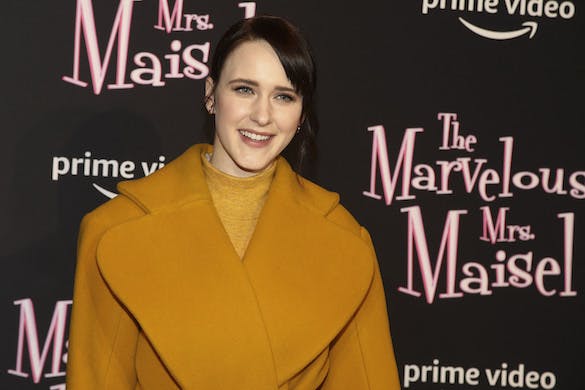Waiting for Mrs. Maisel
‘The Marvelous Mrs. Maisel’ is practically the only show I enjoy so much that I do the opposite of binging: I try to take as much time as possible to watch every episode.

Unbelievable as it seems, the first time I started watching “The Marvelous Mrs. Maisel,” I didn’t immediately love it. This was despite what seemed to be a perfect re-creation of day-to-day life in 1958: the costumes, the sets, the locations, and especially the attitudes of the characters. I was thrown when Midge Maisel started to do her stand-up comedy routines, which are presented in the context of the story.
Instead of sounding like stand-up comedy circa 1958, which mostly dealt with safe, softball topics, Mrs. Maisel was confidently delivering a highly personal monologue involving such taboos as politics, gender roles, and the sex act. Even granted that a few male performers — Lenny Bruce, Mort Sahl — were just starting to address such issues at that time, it seemed extremely unlikely that a novice female comic (at a time when “comediennes” were a rare breed) would be delivering such edgy material.
I persisted, though, and it wasn’t long before I got it: This isn’t a show about re-creating the past; it’s about the past and the present in conflict, rubbing against each other and creating tension. It’s a show where almost everything is as accurate as possible, which serves to make it all the more noticeable when something sticks out, when something is deliberately presented as being an anachronism.
By way of comparison, I once watched an episode of “Mad Men,” another series that takes place in that era, with my books editor and mentor, Robert Gottlieb. We enjoyed it, but Bob had one major caveat: Here was a story taking place in 1961, with characters wearing 1961 outfits, driving 1961 cars, listening to pop music chart hits from 1961, and reading books published in 1961. Bob, who was 30 in 1961, pointed out that most people then were still wearing clothes and driving cars that were at least a few seasons old, that a year is never an end unto itself but rather a collection of what is new and all that comes before it. Hence, this re-creation was almost too perfect.
“Mrs. Maisel” is not about re-creating the past, but reforming it. In a sense it’s an alternate history — not necessarily 1958 as it actually was, but as it might have been. It shows what happens when a comic with a 21st century sensibility is plunked down in a place where everything else is 1958. She’s presented as being ahead of her time, but not in a way that benefits her career. Rather, she is jailed and shunned and attacked in the newspapers. Yet she persists like a prophet without honor (and without profit) in her own country.
The spirit of Lenny Bruce permeates the proceedings vividly; he is the only major historical figure to be directly represented. Luke Kirby does a brilliant job of embodying the comedy maverick, especially as he was in the late 1950s — distinct from the more paranoid, self-focused, drugged-up Lenny Bruce at the end of his short life, less than a decade later.
Incidentally, the Amazon series’s exploration of the contrast between the earlier, family-friendly primetime comics and the more cutting edge, politically oriented monologists seems inspired by Gerald Nachman’s excellent history of the subject, “Seriously Funny: The Rebel Comedians of the 1950s and 1960s” (2003).
Other figures of the time are referenced less directly. Midge Maisel herself owes at least a partial debt to Jean Carroll, perhaps the first female comic to appear regularly on “Ed Sullivan” and other variety shows. More so than some who soon followed in her high-heeled footsteps, like Phyllis Diller and especially Joan Rivers, Carroll’s on-screen persona was a kind of every woman, a housewife who cracked wise about her husband and children but wouldn’t dream of challenging the sexual status quo. Humor was a balm to Carroll, whereas it became a weapon in the manicured hands of Joan Rivers.
Shy Baldwin, played by Leroy McClain (with the exquisite singing voice of Darius de Haas), is a gay African American pop singer trying to negotiate a music business and culture dominated by straight white men. His character is an obvious parallel to Johnny Mathis.
Sophie Leonard, played by the outstanding Jane Lynch, is possibly an almagam of several funny women in various ethnic groups and “markets,” so to speak; sophisticated and, in some cases, educated women who spent their careers playing lowlife characters who were practically the inverse of their real-life personalities, like Loretta Aiken as Moms Mabley and Sarah Ophelia Colley Cannon as Minnie Pearl.
The series is rife with inspired, occasionally recurring characters, like those played by TV vets Jason Alexander and Emily Bergl, but the greatest achievement may be the creation of a world where everyone seems to have a razor sharp sense of humor and everybody speaks in the same lightning-fast speech patterns, like Howard Hawks’s “His Girl Friday” on steroids.
It’s practically the only show I enjoy so much that I do the opposite of binging: I try to take as much time as possible to watch every episode. Even after the fifth season — supposedly the last — has come and gone, I’ll be eagerly awaiting the spinoffs and sequels that will inevitably follow. Surely Midge and Joel’s children, Ethan and Esther, who would be in their mid-60s by 2023, would have grown up to be delightfully dysfunctional enough to sustain their own series.

